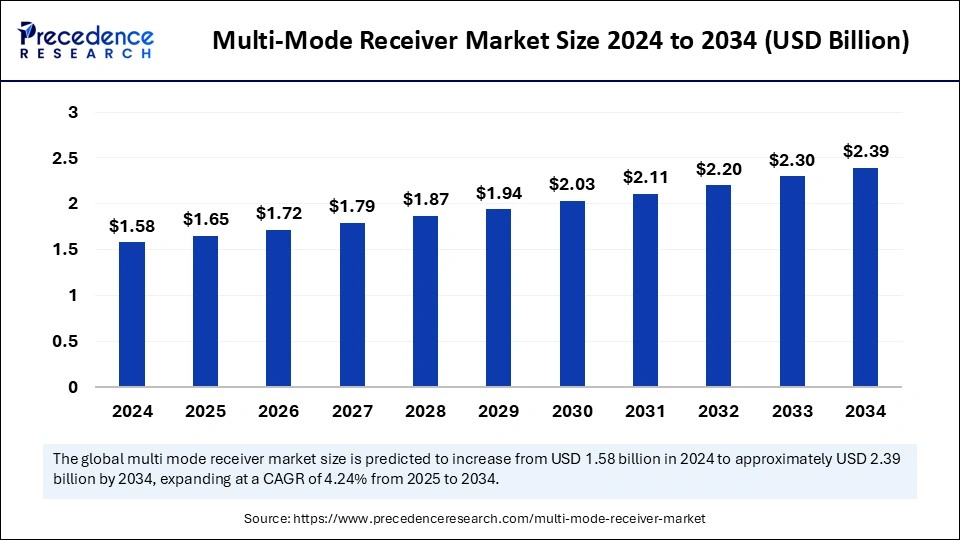Multi-Mode Receiver Market Size to Gain USD 2.39 Bn by 2034
Multi-Mode Receiver Market Size and Forecast 2025 to 2034
The global multi-mode receiver market size was valued at USD 1.58 billion in 2024 and is expected to gain around USD 2.39 billion by 2034, growing at a CAGR of 4.24%.

Get a Free Sample Copy of the Report@ https://www.precedenceresearch.com/sample/5806
Multi-Mode Receiver Market Key Insights
-
With a 38% market share in 2024, North America dominated globally.
-
Asia Pacific is forecasted to achieve the most rapid growth rate through the study period.
-
The fixed-wing segment led by platform type, accounting for 64% in 2024.
-
The rotary-wing segment is anticipated to rise significantly in the future.
-
Line-fit installations led the market by fit in 2024.
-
Retrofit options are expected to expand swiftly in the years to come.
-
Navigation and positioning topped all application types in 2024.
-
Landing functions are projected to grow impressively over the forecast period.
-
Aerospace and defense accounted for the largest market presence in 2024.
-
The telecommunication sector is expected to outpace others in growth.
Navigating the Future: AI’s Role in Advancing MMR Technology
AI is playing a transformative role in the Multi-Mode Receiver market, enhancing both the capabilities and efficiency of these systems. By integrating machine learning algorithms and AI-driven data processing, multi-mode receivers are becoming more adaptive to changing conditions, such as varying signal strength, interference, and noise. AI helps optimize signal detection and processing, allowing receivers to seamlessly switch between different modes (e.g., GPS, GLONASS, Galileo) without manual intervention, improving accuracy and performance.
AI also supports predictive maintenance by monitoring the health of the receiver hardware and analyzing performance data. This allows for early detection of potential failures, minimizing downtime and repair costs. Moreover, AI algorithms improve the integration of multi-mode receivers with other systems, such as autonomous vehicles or drones, enabling real-time decision-making, route optimization, and enhanced navigation performance. As AI technology continues to evolve, it will further enhance the capabilities of multi-mode receivers, driving innovation and expanding their applications across industries like aerospace, defense, telecommunications, and transportation.
Market Overview
The multi-mode receiver (MMR) market is experiencing strong growth due to the increasing demand for advanced navigation and landing systems across aerospace and defense sectors. These receivers integrate multiple navigation technologies such as GPS, GLONASS, Galileo, and SBAS—into a single unit, offering improved reliability, safety, and efficiency. As air traffic grows and automation advances, multi-mode receivers are becoming an essential part of aircraft avionics systems, supporting both military and commercial applications.
Market Scope
| Report Coverage | Details |
| Market Size by 2034 | USD 2.39 Billion |
| Market Size in 2025 | USD 1.65 Billion |
| Market Size in 2024 | USD 1.58 Billion |
| Market Growth Rate from 2025 to 2034 | CAGR of 4.24% |
| Dominated Region | North America |
| Fastest Growing Market | Asia Pacific |
| Base Year | 2024 |
| Forecast Period | 2025 to 2034 |
| Segments Covered | Platform, Fit, Application, End Use, and Regions |
| Regions Covered | North America, Europe, Asia-Pacific, Latin America and Middle East & Africa |
Market Dynamics
Market Drivers
A key driver for the market is the increasing adoption of next-generation aircraft equipped with advanced navigation systems. The aviation industry’s move toward performance-based navigation (PBN) and satellite-based augmentation systems (SBAS) is accelerating the adoption of multi-mode receivers. Additionally, stricter regulatory requirements for aircraft landing and navigation systems by organizations like the FAA and EASA further drive the market growth. The integration of these receivers with autopilot systems and flight management systems also enhances aircraft operational capabilities, boosting their demand.
Opportunities
There are substantial growth opportunities in emerging markets due to increasing investments in modernizing airport infrastructure and air traffic management systems. The growing trend of unmanned aerial vehicles (UAVs) and autonomous aircraft also opens new avenues for multi-mode receivers. Moreover, advancements in AI and machine learning are enabling smart navigation systems that can self-correct in real-time, paving the way for more intelligent, efficient, and adaptive receivers.
Challenges
Despite the growth prospects, the market faces some challenges such as the high cost of integration and certification of advanced avionics systems. Additionally, compatibility issues across different navigation systems and signal interference from urban environments can hinder performance. Cybersecurity risks associated with GPS spoofing and signal jamming are also critical concerns that manufacturers must address to ensure system reliability.
Regional Insights
North America currently dominates the multi-mode receiver market, holding the largest share due to the presence of key aircraft manufacturers and significant defense spending. Asia Pacific is expected to grow at the fastest rate during the forecast period, fueled by rapid expansion in commercial aviation, especially in countries like China and India. Europe remains a strong contributor, with continued investments in aerospace innovation and compliance with evolving navigation standards. The Middle East and Latin America are also emerging markets as regional airlines modernize their fleets and airport systems.
Multi-Mode Receiver Market Companies

- AE Systems
- Garmin Ltd.
- Honeywell International Inc.
- Indra Sistemas
- Intelcan Technosystems Inc.
- Leonardo S.p.A.
- Deere & Company
- Collins Aerospace
- Saab AB
- systems interface (FREQUENCIES)
- Thales
- Trimble
- VAL Avionics Ltd.
Latest Announcements by Market Leaders
- In December 2024, Honeywell announced the signing of a strategic agreement with Bombardier, a global leader in aviation and manufacturer of world-class business jets, to provide advanced technology for current and future Bombardier aircraft in avionics, propulsion, and satellite communications technologies. The collaboration will advance new technology to enable a host of high-value upgrades for the installed Bombardier operator base.
- In March 2025, Garmin, the world’s most innovative and recognized marine electronics manufacturer, announced Force® Pro – a brushless trolling motor engineered with extreme power and Garmin’s most precise GPS positioning technology. It gives anglers everything they love about Force, now with multi-band GPS for superior anchor lock performance and a built-in GT56UHD.
Recent Developments
- In 2024, Collins Aerospace is collaborating with the European Agency for Space Programme (EUSPA) on the Multi-Mode Global Positioning System and Galileo (MUGG) project to enhance the resilience and availability of commercial navigation systems. This initiative focuses on developing a dual-frequency, multi-constellation satellite-based augmentation system (SBAS) receiver.
- In December 2024, Honeywell revealed that Avianca chose its avionics and mechanical systems for its new Airbus A320neo fleet to optimize operational performance. The list comprises Honeywell’s 131-9A APUs, Pegasus II A320 FMS, IntuVue RDR-4000 weather radar, TCAS, and the Integrated Multi-Mode Receiver, enhancing navigation and situational awareness for pilots.
Segments Covered in the Report
By Platform
- Fixed-wing
- Rotary-wing
By Fit
- Line-fit
- Retrofit
By Application
- Navigation & Positioning
- Landing
- Others
By End-Use
- Telecommunications
- Automotive
- Aerospace and Defense
- Marine and Shipping
- Agriculture
- Construction and Surveying
- Transportation and Logistics
- Others
By Geography
- North America
- Europe
- Asia Pacific
- Latin America
- Middle East and Africa
Also Read: RF GaN Market
Ready for more? Dive into the full experience on our website@ https://www.precedenceresearch.com/
